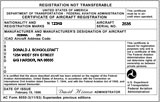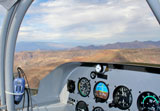|
FAR 91.207 - Emergency locator transmitters(a) Except as provided in paragraphs (e) and (f) of this section, no person may operate a U.S.-registered civil airplane unless— (1) There is attached to the airplane an approved automatic type emergency locator transmitter that is in operable condition for the following operations, except that after June 21, 1995, an emergency locator transmitter that meets the requirements of TSO-C91 may not be used for new installations: (i) Those operations governed by the supplemental air carrier and commercial operator rules of parts 121 and 125; (ii) Charter flights governed by the domestic and flag air carrier rules of part 121 of this chapter; and (iii) Operations governed by part 135 of this chapter; or (2) For operations other than those specified in paragraph (a)(1) of this section, there must be attached to the airplane an approved personal type or an approved automatic type emergency locator transmitter that is in operable condition, except that after June 21, 1995, an emergency locator transmitter that meets the requirements of TSO-C91 may not be used for new installations. (b) Each emergency locator transmitter required by paragraph (a) of this section must be attached to the airplane in such a manner that the probability of damage to the transmitter in the event of crash impact is minimized. Fixed and deployable automatic type transmitters must be attached to the airplane as far aft as practicable. (c) Batteries used in the emergency locator transmitters required by paragraphs (a) and (b) of this section must be replaced (or recharged, if the batteries are rechargeable)— (1) When the transmitter has been in use for more than 1 cumulative hour; or (2) When 50 percent of their useful life (or, for rechargeable batteries, 50 percent of their useful life of charge) has expired, as established by the transmitter manufacturer under its approval. The new expiration date for replacing (or recharging) the battery must be legibly marked on the outside of the transmitter and entered in the aircraft maintenance record. Paragraph (c)(2) of this section does not apply to batteries (such as water-activated batteries) that are essentially unaffected during probable storage intervals. (d) Each emergency locator transmitter required by paragraph (a) of this section must be inspected within 12 calendar months after the last inspection for— (1) Proper installation; (2) Battery corrosion; (3) Operation of the controls and crash sensor; and (4) The presence of a sufficient signal radiated from its antenna. (e) Notwithstanding paragraph (a) of this section, a person may— (1) Ferry a newly acquired airplane from the place where possession of it was taken to a place where the emergency locator transmitter is to be installed; and (2) Ferry an airplane with an inoperative emergency locator transmitter from a place where repairs or replacements cannot be made to a place where they can be made. No person other than required crewmembers may be carried aboard an airplane being ferried under paragraph (e) of this section. (f) Paragraph (a) of this section does not apply to— (1) Before January 1, 2004, turbojet-powered aircraft; (2) Aircraft while engaged in scheduled flights by scheduled air carriers; (3) Aircraft while engaged in training operations conducted entirely within a 50-nautical mile radius of the airport from which such local flight operations began; (4) Aircraft while engaged in flight operations incident to design and testing; (5) New aircraft while engaged in flight operations incident to their manufacture, preparation, and delivery; (6) Aircraft while engaged in flight operations incident to the aerial application of chemicals and other substances for agricultural purposes; (7) Aircraft certificated by the Administrator for research and development purposes; (8) Aircraft while used for showing compliance with regulations, crew training, exhibition, air racing, or market surveys; (9) Aircraft equipped to carry not more than one person. (10) An aircraft during any period for which the transmitter has been temporarily removed for inspection, repair, modification, or replacement, subject to the following: (i) No person may operate the aircraft unless the aircraft records contain an entry which includes the date of initial removal, the make, model, serial number, and reason for removing the transmitter, and a placard located in view of the pilot to show “ELT not installed.” (ii) No person may operate the aircraft more than 90 days after the ELT is initially removed from the aircraft; and (11) On and after January 1, 2004, aircraft with a maximum payload capacity of more than 18,000 pounds when used in air transportation. [Doc. No. 18334, 54 FR 34304, Aug. 18, 1989, as amended by Amdt. 91–242, 59 FR 32057, June 21, 1994; 59 FR 34578, July 6, 1994; Amdt. 91–265, 65 FR 81319, Dec. 22, 2000; 66 FR 16316, Mar. 23, 2001]
|









